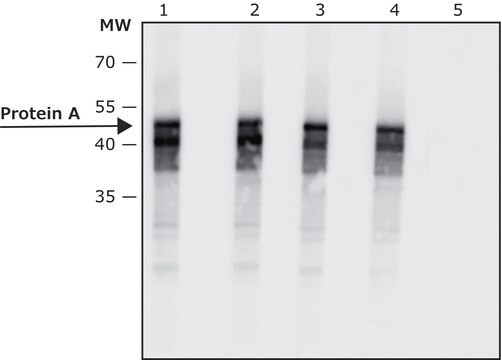P7837
Protein A from Staphylococcus aureus
Soluble, Cowan strain, recombinant, expressed in E. coli, aqueous solution, ≥95% (HPLC)
Sign Into View Organizational & Contract Pricing
All Photos(1)
About This Item
Recommended Products
recombinant
expressed in E. coli
Quality Level
conjugate
unconjugated
Assay
≥95% (HPLC)
form
aqueous solution
mol wt
45,000
impurities
endotoxin, tested
UniProt accession no.
storage temp.
−20°C
Gene Information
Staphylococcus aureus subsp. aureus NCTC 8325 ... SAOUHSC_00069(3919448)
Looking for similar products? Visit Product Comparison Guide
Application
Protein A may be conjugated with various reporter molecules including fluorescent dyes (FITC), enzyme markers (peroxidase, β-galactosidase, alkaline phosphatase), biotin, and colloidal gold without affecting the antibody binding site on the molecule. These conjugates are used to detect immunoglobulins in various immunochemical assays including western blotting, immunohistochemistry, and ELISA applications. In addition, protein A may be immobilized on a solid support such as agarose or acrylic beads for the purification of either polyclonal or monoclonal immunoglobulins. It is also routinely used for immunoprecipitation assays.
Biochem/physiol Actions
Protein A is a highly stable cell surface receptor produced by several strains of Staphylococcus aureus. It consists of a single polypeptide chain of molecular weight 42 kDa, containing four repetitive domains rich in aspartic and glutamic acids but devoid of cysteine. It contains little or no carbohydrate and only 4 tyrosine residues and no tryptophans. Protein A is capable of binding to the Fc portion of immunoglobulins, especially IgGs, from a large number of species. One protein A molecule has been shown to bind at least 2 molecules of IgG simultaneously. The IgG binding domain of Protein A consists of three anti-parallel α-helicies, the third of which is disrupted when the protein is complexed with the Fc region of the immunoglobulins. Protein A will bind the Fc portion of human IgG subclasses, IgM, IgA and IgE; and mouse IgG1 (weakly), IgG2a, and IgG2b. Protein A also binds IgGs from other species, including monkey, rabbit, pig, guinea pig, dog, and cat.
Protein A also participates in a number of different protective biological functions including anti-tumor, toxic, and carcinogenic activities. In addition to acting as an immunomodulator, it also has antifungal and antiparasitic properties.
Protein A also participates in a number of different protective biological functions including anti-tumor, toxic, and carcinogenic activities. In addition to acting as an immunomodulator, it also has antifungal and antiparasitic properties.
Disclaimer
Unless otherwise stated in our catalog or other company documentation accompanying the product(s), our products are intended for research use only and are not to be used for any other purpose, which includes but is not limited to, unauthorized commercial uses, in vitro diagnostic uses, ex vivo or in vivo therapeutic uses or any type of consumption or application to humans or animals.
Storage Class Code
11 - Combustible Solids
WGK
WGK 3
Flash Point(F)
Not applicable
Flash Point(C)
Not applicable
Personal Protective Equipment
dust mask type N95 (US), Eyeshields, Gloves
Choose from one of the most recent versions:
Already Own This Product?
Find documentation for the products that you have recently purchased in the Document Library.
Customers Also Viewed
Microplate-based chromatin immunoprecipitation method, Matrix ChIP: a platform to study signaling of complex genomic events.
Flanagin S et al
Nucleic Acids Research, 36(3), e17-e17 (2008)
Chaitali P Basole et al.
Cellular signalling, 40, 62-72 (2017-08-31)
The levels of cAMP are regulated by phosphodiesterase enzymes (PDEs), which are targets for the treatment of inflammatory disorders. We have previously shown that PDE8 regulates T cell motility. Here, for the first time, we report that PDE8A exerts part
Wan-Jong Kuo et al.
Molecular biology of the cell, 21(22), 4028-4041 (2010-09-24)
Cell surface heparan sulfate (HS) not only binds several major classes of growth factors but also sometimes potentiates their activities--an effect usually termed "coreception." A view that coreception is due to the stabilization of growth factor-receptor interactions has emerged primarily
spa typing method for discriminating among Staphylococcus aureus isolates: implications for use of a single marker to detect genetic micro- and macrovariation.
Koreen L et al
Journal of Clinical Microbiology, 42(2), 792-799 (2004)
Masayo Naito et al.
The American journal of pathology, 174(1), 54-62 (2008-12-20)
Acute kidney injury evokes renal tubular cholesterol synthesis. However, the factors during acute kidney injury that regulate HMG CoA reductase (HMGCR) activity, the rate-limiting step in cholesterol synthesis, have not been defined. To investigate these factors, mice were subjected to
Our team of scientists has experience in all areas of research including Life Science, Material Science, Chemical Synthesis, Chromatography, Analytical and many others.
Contact Technical Service









